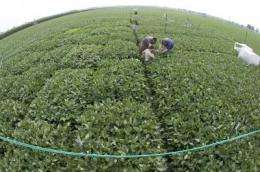High CO2 boosts plant respiration, potentially affecting climate and crops

The leaves of soybeans grown at the elevated carbon dioxide (CO2) levels predicted for the year 2050 respire more than those grown under current atmospheric conditions, researchers report, a finding that will help fine-tune climate models and could point to increased crop yields as CO2 levels rise.
The study, from researchers at the University of Illinois and the U.S. Dept. of Agriculture, appears this week in the Proceedings of the National Academy of Sciences.
Plants draw CO2 from the atmosphere and make sugars through the process of photosynthesis. But they also release some CO2 during respiration as they use the sugars to generate energy for self-maintenance and growth. How elevated CO2 affects plant respiration will therefore influence future food supplies and the extent to which plants can capture CO2 from the air and store it as carbon in their tissues.
While there is broad agreement that higher atmospheric CO2 levels stimulate photosynthesis in C3 plants, such as soybean, no such consensus exists on how rising CO2 levels will affect plant respiration.
"There's been a great deal of controversy about how plant respiration responds to elevated CO2," said U. of I. plant biology professor Andrew Leakey, who led the study. "Some summary studies suggest it will go down by 18 percent, some suggest it won't change, and some suggest it will increase as much as 11 percent."
Understanding how the respiratory pathway responds when plants are grown at elevated CO2 is key to reducing this uncertainty, Leakey said. His team used microarrays, a genomic tool that can detect changes in the activity of thousands of genes at a time, to learn which genes in the high CO2 plants were being switched on at higher or lower levels than those of the soybeans grown at current CO2 levels.
Rather than assessing plants grown in chambers in a greenhouse, as most studies have done, Leakey's team made use of the Soybean Free Air Concentration Enrichment (Soy FACE) facility at Illinois. This open-air research lab can expose a soybean field to a variety of atmospheric CO2 levels - without isolating the plants from other environmental influences, such as rainfall, sunlight and insects.
Some of the plants were exposed to atmospheric CO2 levels of 550 parts per million (ppm), the level predicted for the year 2050 if current trends continue. These were compared to plants grown at ambient CO2 levels (380 ppm).
The results were striking. At least 90 different genes coding the majority of enzymes in the cascade of chemical reactions that govern respiration were switched on (expressed) at higher levels in the soybeans grown at high CO2 levels. This explained how the plants were able to use the increased supply of sugars from stimulated photosynthesis under high CO2 conditions to produce energy, Leakey said. The rate of respiration increased 37 percent at the elevated CO2 levels.
The enhanced respiration is likely to support greater transport of sugars from leaves to other growing parts of the plant, including the seeds, Leakey said.
"The expression of over 600 genes was altered by elevated CO2 in total, which will help us to understand how the response is regulated and also hopefully produce crops that will perform better in the future," he said.
Source: University of Illinois at Urbana-Champaign




















